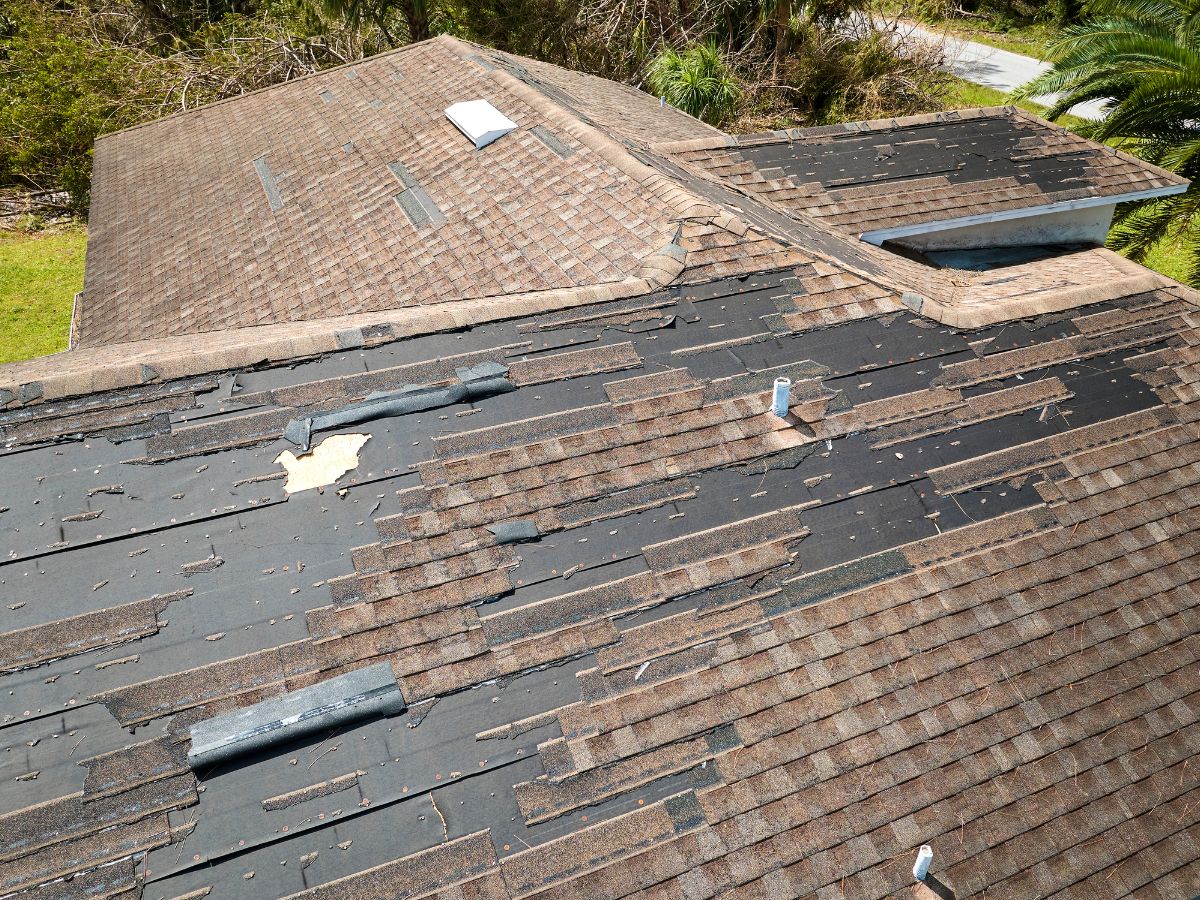How long can a roof last depends greatly on the material used. Asphalt shingles typically have a lifespan ranging from 15 years to 30 years. Metal roofs, on the other hand can last for a significantly longer period, usually between 40 & 70 years. Tile roofs may exceed 50 years under ideal conditions. Warning signs indicating the need for replacement include missing or curled shingles, water stains, and sagging structures. Recognizing these signs can help homeowners avoid costly repairs. To ensure longevity, understanding maintenance practices is essential. More insights on this topic await.
Key Takeaways
- Roof lifespan varies by material: asphalt shingles last 15-30 years, while metal roofs can last 40-70 years.
- Warning signs for replacement include missing shingles, water stains, and visible daylight through roof boards.
- Regular maintenance can extend roof life; conduct inspections and clean gutters to prevent damage.
- Climate affects roof durability; extreme heat can shorten asphalt shingles’ lifespan to 15-20 years.
- A sagging roof line or granules in gutters indicates significant wear and potential need for replacement.
How Long Can a Roof Last Based on Material and Maintenance

The lifespan of a roof can vary significantly based on the material used and the level of maintenance it receives. Homeowners often wonder how long a roof can last, and the answer largely depends on the roofing material.
For instance, asphalt shingles typically have an average lifespan of 15 to 30 years, while metal roofs can last 40 to 70 years. Tile roofs, known for their durability, may exceed 50 years under optimal conditions.
Maintenance plays a crucial role in determining the longevity of a roof. Regular inspections, cleaning, and prompt repairs can extend its lifespan significantly. Neglecting minor issues can lead to larger problems, decreasing the overall durability.
Ultimately, understanding the average lifespan of a roof according to its material and the importance of maintenance helps homeowners make informed decisions about their roofing needs.
Common Warning Signs You Need a New Roof

How can homeowners recognize when it’s time for a roof replacement? Understanding the warning signs you need a new roof is crucial for maintaining the integrity of a home. Homeowners should be vigilant in assessing their roofs for specific indicators that replacement is necessary.
- Missing or curled shingles
- Water stains on ceilings or walls
- Granules from shingles in gutters
- Daylight visible through roof boards
- Sagging or uneven roof lines
These symptoms often signal that the roof’s protective barrier has been compromised. Not addressing these warning signs can lead to further damage and costly repairs.
Homeowners must take action when these issues arise, as they are key indicators of when a roof needs to be replaced. Regular inspections and maintenance can help prevent more severe problems down the line, ensuring a safe and efficient home environment.
The Average Lifespan of a Roof in Different Climates

While various factors influence a roof’s lifespan, climate plays a pivotal role in determining how long different roofing materials will last.
In temperate climates, asphalt shingles typically last around 20 to 25 years, while metal roofs may endure for 40 years or more. In contrast, regions with extreme heat can shorten the lifespan of asphalt shingles due to increased wear from UV exposure, often reducing their longevity to 15-20 years.
Conversely, in colder climates, roofing materials face challenges from snow and ice, which can lead to ice dams and increased moisture exposure.
Here, asphalt shingles may also last between 20 to 25 years, whereas slate or tile roofs, often favored in these areas for their durability, can last upwards of 50 years.
Understanding these variations helps homeowners anticipate maintenance needs and plan for eventual roof replacements based on their local climate conditions.
Factors That Affect the Average Lifespan of a Roof

Numerous factors influence the average lifespan of a roof, determining not only how long it will last but also its overall performance. Homeowners must consider these elements to ensure the longevity of their roofing systems.
- Material Type: Different roofing materials, such as asphalt shingles, metal, or tile, have varying lifespans and durability.
- Climate Conditions: Environmental factors like temperature fluctuations, humidity, and precipitation levels can significantly impact a roof’s lifespan.
- Installation Quality: Proper installation by experienced professionals is crucial; poor workmanship can lead to premature deterioration.
- Maintenance Practices: Regular inspections and maintenance can identify issues early, preventing further damage and extending the roof’s life.
- Roof Design: The slope and structure of the roof can affect water drainage, influencing wear and tear over time.
Understanding these factors enables homeowners to make informed decisions about their roofing systems.
When Does a Roof Need to Be Replaced to Avoid Major Repairs

When does a roof need to be replaced? This is a key question for homeowners looking to avoid costly repairs. Recognizing the signs of deterioration is crucial. A roof nearing the end of its lifespan, typically between 20 to 30 years depending on material, may warrant replacement.
Visible signs such as missing shingles, significant curling, or extensive granule loss indicate that the roof’s integrity is compromised. Stains on ceilings or walls often suggest leaks, which can lead to expensive interior damage if not addressed promptly.
Additionally, if a roof has experienced multiple repairs or its underlayment is damaged, replacement may be more cost-effective in the long run. Homeowners should also consider the local climate, as extreme weather can accelerate wear and tear.
Ultimately, proactive replacement can help prevent major repairs, ensuring the safety and efficiency of the home.
Maintenance Tips That Help Your Roof Last for Years

Homeowners can significantly extend the lifespan of their roofs with proper maintenance practices.
Regular upkeep not only prevents costly repairs but also enhances the overall durability of roofing materials.
Here are several essential maintenance tips:
- Inspect Regularly: Conduct visual inspections at least twice a year to identify early signs of wear or damage.
- Clean Gutters: Ensure gutters are free of debris to facilitate proper water drainage and prevent water accumulation.
- Trim Overhanging Branches: Keep tree branches trimmed to avoid damage from falling limbs and to reduce debris buildup.
- Remove Moss and Algae: Regularly clean any growth that can retain moisture and weaken roofing materials.
- Schedule Professional Inspections: Hire a professional roofing contractor for thorough inspections every few years to catch issues that may go unnoticed.
FAQ: Roof Lifespan and Maintenance
How can I tell if my roof needs replacing?
Look for warning signs such as missing or curled shingles, water stains on ceilings or walls, excessive granule loss in gutters, sagging roof lines, or visible daylight through roof boards. These indicators often signal that the roof’s protective barrier is failing and may require replacement.
What’s the best way to maintain my roof to make it last longer?
Schedule regular inspections at least twice a year, clean your gutters, trim overhanging branches, remove moss or algae, and check for damaged flashing or shingles. Promptly addressing minor issues helps prevent costly repairs and extends your roof’s lifespan.
How can I prolong my roof’s lifespan?
Use high-quality materials, ensure professional installation, and follow a consistent maintenance plan. Protect your roof from climate-related wear by tailoring care to local weather conditions—such as addressing UV damage in hot climates or ice buildup in colder regions.
Can a roof last longer than its expected lifespan?
Yes, with proper care and favorable conditions, a roof can exceed its typical lifespan. For example, asphalt shingles rated for 25 years may last longer if well-maintained, and materials like metal or tile can often surpass their expected durability with consistent upkeep.
Final Thoughts
Understanding how long a roof can last helps homeowners plan wisely and avoid unexpected repairs. With lifespans varying by material and climate, routine maintenance becomes essential in preserving a roof’s condition. From spotting early warning signs to conducting regular inspections and addressing minor issues promptly, proactive care can extend the life of your roof and protect your investment.
To get the most from your roofing system, explore our roofing maintenance tips and see how different roofing materials compare by cost and longevity.
Ready to assess the condition of your roof or plan for a replacement? Contact Texas Stag Roofing Solutions today to schedule a professional inspection and experience roofing done with honesty, quality, and care.


